Wednesday, August 21, 2019
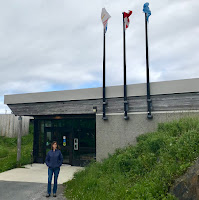 |
Eagerly awaiting Entry into the
L’Anse aux Meadows Visitor Center |
This morning, we drove down the road a mere 9 km to visit L’Anse aux Meadows National Historic Site. Jane has been talking about this site for months and months and so was excited to finally be there (fee-free due to our Discovery Pass).
L’Anse aux Meadows is the first and only authentically proven Viking settlement site in North America. The Icelandic Vinland sagas, passed down orally for generations and then recorded in the 1200s, suggest that the Vikings had been to this continent. But it wasn’t until 1960 that the discovery of overgrown ruins of 11th-century Norse buildings with iron works and wood from European tree species, that this speculation was verified.
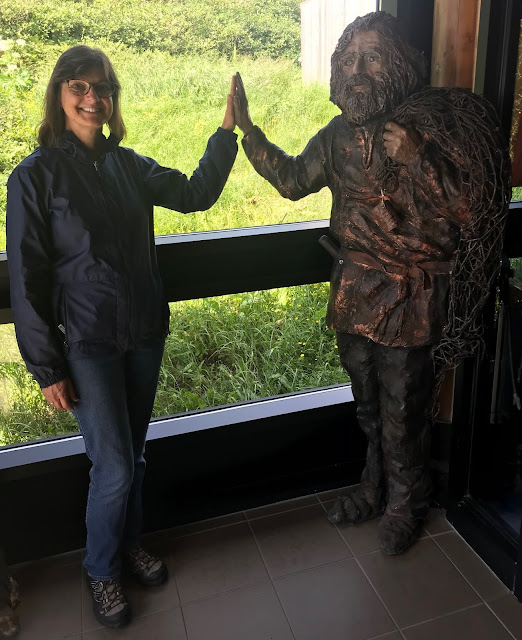 |
| Leif Eriksson High-Fives Jane |
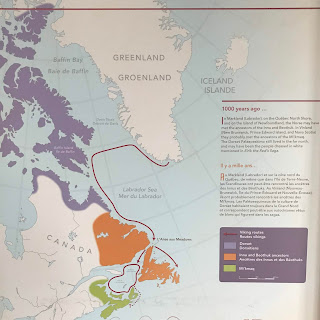 |
| The Norse Route to L’Anse aux Meadows |
Over a thousand years ago, the Norse had settled Iceland and Greenland. Greenland had no trees and insufficient vegetation to comfortably support the 500 inhabitants. So, Leif Eriksson and crew set out to discover new resources following the path where a fellow Viking had reported seeing a verdant coastline while blown off course in a storm. After a short nine-day voyage, they encountered the Labrador coast and sailed south to set up a base camp at L’Anse aux Meadows on the northern tip of Newfoundland. This base camp supported the Norse people as they exploited the resources in the Labrador region that they named Markland and south in the Nova Scotia and New Brunswick region that they named Vinland. They encountered and traded with the Native Americans but refused to trade their iron goods. After a decade, the Norse decided to abandon their North American base taking their valuables and burning the village before departing. Their reason for leaving is unknown but may have been because of conflicts with the natives.
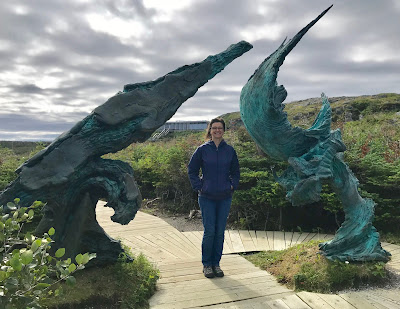 |
Meeting of Two Worlds by Sculptors
Luben Boykov & Richard Brixel |
The interpretive information at the center put the meeting of the Norse and Native American peoples into perspective. About 100,000 years ago our human ancestors expanded out of Africa. Some went left (west into Europe) and some went right (east into Asia). By 40,000 years ago, people had reached Australia and began populating the islands of the Pacific Ocean. As the last glaciation ended around 15,000 year ago, people entered North America from Siberia in several waves by walking across the exposed Beringian Plains. Within another thousand years people had spread to the southern tip of South America and across North America to the Atlantic Ocean. Although humans now encircled the globe, the vast Atlantic Ocean still separated the eastern and western branches until about 1,000 years ago when Norse and Native American people first encountered one another completing the circle of humanity.
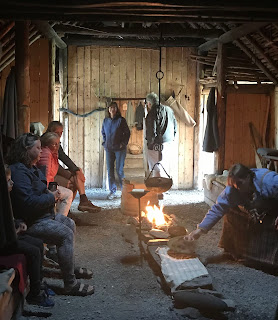 |
Inside the Main Building of the
Recreated Norse Settlement |
The visitor center had a short film and lots of informational displays concerning the settlement. Outside, there was a boardwalk that passed by the labelled mounds of the historic settlement. But, we spent most of our time walking through bunkers covered with vegetation in a recreated village that was surrounded by wooden fencing. Various buildings were furnished to simulate living quarters, storage areas, work shops, kitchens, and other daily needs of the Norse settlers. Various Viking re-enactors greeted us to demonstrate the period clothing and lifestyle.
Along the boardwalk on our return trip, Jane and I had two new Newfie experiences. Firstly, we sampled the wild bakeapples (cloudberries) growing alongside the boardwalk. We’ve seen Newfies collecting and selling these wild berries throughout our visit here. A local picked out some ripe yellowish ones for us to sample. They were tasty and not overly tart like the darker orange ones that others were sampling as they made faces. Secondly, after a short walk down the path, Jane spotted a female moose (Cowwinkle) in the distance. Later, a guide said that the moose was caring for two mooselets, but we never saw them.
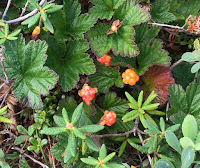 |
| Bakeapples (cloudberries) |
We left L’Anse aux Meadows, seeking lunch at the nearby Norse Restaurant. Unfortunately, as we arrived, a huge tour bus almost the size of the small restaurant building was unloading. So, we went down the road and pulled over to enjoy a delicious lunch in the RV with an exceptional cove view. After lunch as we passed the restaurant, the bus was still parked there and Jane commented that we probably wouldn’t have even been served a glass of water yet if we had opted to eat there.
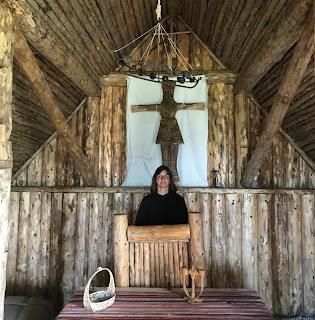 |
| Norse Priestess Janie delivers the Sermon |
Also near the restaurant, we visited Norstead, another Viking settlement recreation. So, we once again stepped back into the Viking era and immersed ourselves in the sights, sounds and scents of a Norse village. This one was larger than the L’Anse aux Meadows site which had remained true to the structures found there. In the main building, we were able to don helmets and pose for pictures in the rulers’ chairs. In the Norstead boathouse, there was a modern recreation of a Viking ship. I have seen the ancient boat relics that this was designed from in a display in Roskilde, Denmark. The modern version at Norstead had actually been sailed from Greenland to Newfoundland, however it took the modern crew about three times longer than Leif’s crew.
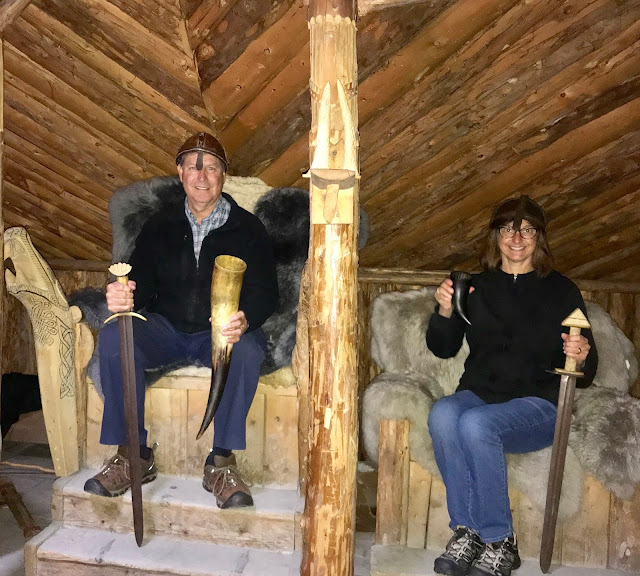 |
| King and Queen (for 3 minutes in an imaginary village in the middle of nowhere, sigh.) |
 |
| Norstead is surround by a Beautiful Landscape |
Next we drove back through St. Lunaire-Griquet and stopped at the Dark Tickle store where Jane purchased some of their berry products: blueberry jam, partridgeberry jam and bakeapple sauce.
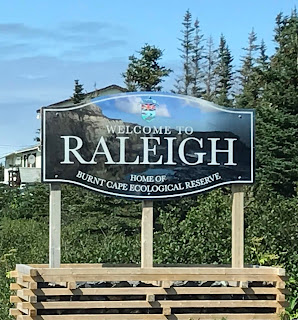 |
| From Raleigh to Raleigh |
Then, it was on to Raleigh! Yes, after traveling thousands of miles from Raleigh we were finally there. Raleigh is another cute cove town and “Home of Burnt Cape Ecological Reserve”. Jane dropped into the only store (and post office) and we then drove around the small village. After seeing Raleigh, we headed to St. Anthony, the largest town on this end of The Rock, and after driving around it a little, headed back toward the campground.
We dined at The Daily Catch restaurant where we had a delicious three course meal and listened to the music of a local who grew up a few miles from the restaurant. He sang mostly original ballads accompanied by guitar or accordion. The washrooms were conveniently labelled “Jane” and “John” so that we wouldn’t get confused. We returned to the RV with bellies full of good food and heads full of sea chanties.
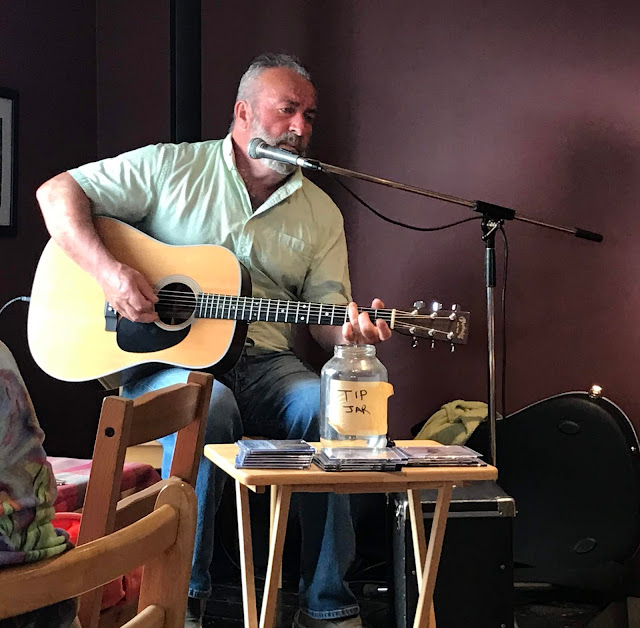 |
| Our Entertainer at The Daily Catch |










